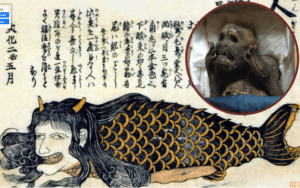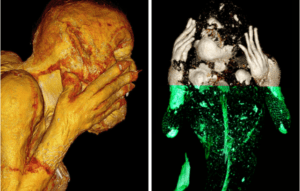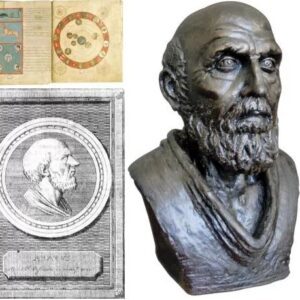
The mysterious mummified mermaid, one of thirteen similar objects, has puzzled researchers for decades. The mermaid, which dates back to the 1700s, was used by priests of Japan’s Enjuin temple as a healing talisman. After 40 years in a fireproof safe, researchers were finally able to examine the mermaid closely and make an astonishing discovery.
The bizarre story of the 18th-century miracle mermaid
The origins of the mermaid mummy are unclear, but it has long been stored in a box with a memo claiming it was caught in a fishing net off the coast of Kochi, Japan between 1736 and 1740. It was then sold to the ancestor of Mr. Naojo Kojima, a member of the Bingo Fukuyama clan during the Edo period. The mermaid remained a Kojima family heirloom until it eventually ended up in the possession of the Enjuin temple

The mummified mermaid in the box it is kept in at the Japanese temple
The mermaid mummy was kept in a safe at the Enjuin temple to preserve its condition. However, in February 2022, the mummy was taken out of storage to be studied by scientists at the Kurashiki University of Science and the Arts (KUSA). The researchers conducted a thorough investigation that involved various techniques such as X-rays, CT scans, microscopic observations, DNA analysis, and radiocarbon dating. The purpose of the study was to uncover the true origins of the mummy and shed light on the mystery that has surrounded it for decades.
What is the mummy really made of?
According to a statement from the researchers, their investigation revealed that the teeth of the mummy were all conical and slightly curved backwards inside the mouth, resembling the jaw of an unknown species of carnivorous fish. The body of the creature was painted with sand or charcoal powder, and its arms had five fingers and flat claws. The lower body had dorsal fins, rear fins, and caudal fins, and was covered with scales. Furthermore, radiocarbon dating showed that the mummy was created around 1800, which differs from the previous belief that it was from the 1700s.

CT scans and images of the mummy show its strange composition.
Researchers concluded that the “fish body” of the specimen was made of cloth, paper, and cotton while “pufferfish skin is used on the arms, shoulders, neck, and cheeks.” The hair on the body comes from some kind of mammal, and animal keratin was used for the nails, but the exact DNA of the creature “could not be detected.” This isn’t the only mermaid, either – in fact, there are another 12 similar specimens.
While European depictions of mermaids typically feature a beautiful woman with long hair and a long, fish-like tail, Japanese mermaids, or ningyo (which translates to “human fish”), appear much more fish-like. In Japanese folklore, the ningyo have shiny golden scales, a monkey’s mouth, and a voice that resembles a flute. “Japanese mermaids have a legend of immortality,” Hiroshi Kinoshita of the Okayama Folklore Society told Metro. “It is said that if you eat the flesh of a mermaid, you will never die. There is a legend in many parts of Japan that a woman accidentally ate the flesh of a mermaid and lived for 800 years.”
More from us: What is ‘Mermaiding’? The Water-Ful History Behind the Social Media Trend
To clarify, while the mermaid mummy is not a naturally occurring creature, it is not necessarily a hoax in the sense that it was intentionally created to deceive people. It was likely made by combining the body parts of various animals, such as a monkey and a fish, in a way that would create a creature resembling a mermaid. This was a common practice in Japan during the Edo period, where such creations were known as “kijimuna.” While it is not a genuine mermaid, the mummy does have cultural and historical significance as a relic of Japanese folklore and traditional healing practices.





